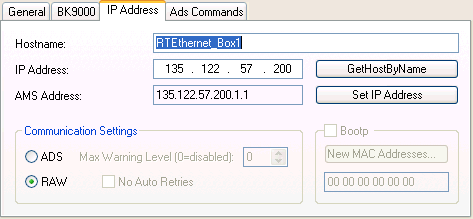"IP Address" Tab
Ethernet components need an unique IP address to be able to communicate. Subsequently, the dialog for the configuration of the specific settings at a Beckhoff Ethernet fieldbus node is described. The following tab appears after marking or adding of such an Ethernet device in / to the System Manager tree.

Hostname: The name of the Beckhoff Ethernet node can be edited here.
IP Address: The IP address of the Beckhoff component ( e.g. BK9000) has to be set here.
| Bit7 | Bit6 | Bit5 | Bit4 | Bit3 | Bit2 | Bit1 | Bit0 |
fix IP address | 0 | 0 | Last digit of IP address e. g. 135.122.57. {Bit5-Bit0} | |||||
Boot P | 0 | 1 | 0-5 to ON stores BootP address permanently | 0-5 to OFF stores BootP address volatile | ||||
DHCP | 1 | 0 | Settings creates DHCP name | |||||
GetHostByName: From Firmware "B2" on, an IP address for the node (Box) can be obtained from a Windows 2000 DHCP Server (Dynamic Host Configuration Protocol).
Set IP Address: At TwinCAT Real-Time Ethernet nodes, this button can be pushed to set the IP Address conform to the subnet address used by the Ethernet Miniport (real-time) device.
AMS Address: Specifies the AMS-Net ID of this node. This ID is generated automatically, derived from the IP address (2 additional byte values separated by dots (e.g. ".1.1").
BootP: This box can be checked, if the Beckhoff BootP Server has been installed and started on the computer (Requirements: TwinCAT 2.8 or higher).
New MAC Addresses: With a started -> "Beckhoff Bootp Server" and pressing of this button, newfound MAC (Media Access Controller) addresses are shown. They are displayed in the field under the button. In the case there is only one new Beckhoff Ethernet device hooked up to the network, only one MAC address is shown. For this MAC address an IP address can be assigned in the above described edit field. With adding of another Beckhoff Ethernet node, this procedure can be repeated on this tab of the new node (Box).
Communication Settings:
TCP: If this radio button is active (default at non-real time devices), the communication is done over TCP (Transmission Control Protocol ). That means, telegram packages from and to the node are exchanged through a safed (confirmed) mechanism.
ADS (): available at TwinCAT Real-Time Ethernet nodes If this radio button is active ...
UDP: If this radio button is active, the communication is done via UDP (User Datagram Protocol ). In difference to the TCP protocol, the single telegram packages are not confirmed by the recipient, nor is the order of the packages approved (means, UDP provides very few error recovery services). Damaged or interchanged telegram packages won't be sent again. The advantage of UDP consists of predictable telegram run times because there is no waiting for a confirmation by recipient. Therefore, UDP is in contrast to TCP/IP the faster communication method, since no TCP/IP stack is necessary for it.
RAW : (available at TwinCAT Real-Time Ethernet nodes) If this radio button is active (default at TwinCAT Real-Time Ethernet nodes), the communication to this node is handled via TwinCAT Real-Time Ethernet protocol.
Max. Warning Level: This option is only available in combination with UDP. The maximum value for the error counter can be set here. If this max. value is reached, the master doesn't wait for a response telegram with new inputs from the node. Instead, it sends only read telegrams, based on a higher cycle time to the node.
No Auto Retries: This box can only checked in combination with UDP either. Is this box checked, with reaching of Max. Warning Level an execution of the -> "Online Reset" function is necessary.
"ADS Commands" Tab
For information about this tab, see -> "ADS Command Window".